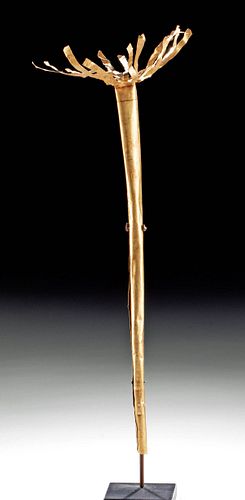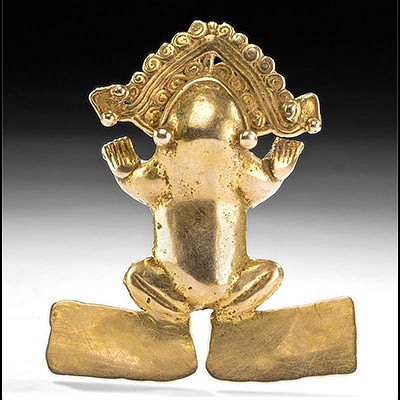Greco-Phoenician 22K+ Gold Votive Fly Whisk, 19.5 g
Lot 15d
About Seller
Artemis Fine Arts
686 S Taylor Ave, Ste 106
Louisville, CO 80027
United States
Selling antiquities, ancient and ethnographic art online since 1993, Artemis Gallery specializes in Classical Antiquities (Egyptian, Greek, Roman, Near Eastern), Asian, Pre-Columbian, African / Tribal / Oceanographic art. Our extensive inventory includes pottery, stone, metal, wood, glass and textil...Read more
Categories
Estimate:
$16,000 - $24,000
Absentee vs Live bid
Two ways to bid:
- Leave a max absentee bid and the platform will bid on your behalf up to your maximum bid during the live auction.
- Bid live during the auction and your bids will be submitted real-time to the auctioneer.
Bid Increments
| Price | Bid Increment |
|---|---|
| $0 | $25 |
| $300 | $50 |
| $1,000 | $100 |
| $2,000 | $250 |
| $5,000 | $500 |
| $10,000 | $1,000 |
| $20,000 | $2,500 |
| $50,000 | $5,000 |
| $100,000 | $10,000 |
| $200,000 | $20,000 |
About Auction
By Artemis Fine Arts
Aug 13, 2020
Set Reminder
2020-08-13 10:00:00
2020-08-13 10:00:00
America/New_York
Bidsquare
Bidsquare : Fine Antiquities, Ethnographic & Fine Art
https://www.bidsquare.com/auctions/artemis-gallery/fine-antiquities-ethnographic-fine-art-5415
Features classical antiquities, ancient and ethnographic art from cultures encompassing the globe. Egyptian, Greek, Roman, Etruscan, Near Eastern, Asian, Pre-Columbian, Native American, African / Tribal, Oceanic, Spanish Colonial, Russian, Fine Art, so much more! Artemis Fine Arts info@artemisgallery.com
Features classical antiquities, ancient and ethnographic art from cultures encompassing the globe. Egyptian, Greek, Roman, Etruscan, Near Eastern, Asian, Pre-Columbian, Native American, African / Tribal, Oceanic, Spanish Colonial, Russian, Fine Art, so much more! Artemis Fine Arts info@artemisgallery.com
- Lot Description
Ancient Eastern Mediterranean, Greco-Phoenician to Hellenistic period, ca. 5th to 3rd century BCE. A stunning votive fly whisk formed from a sheet of 93% gold (equivalent to 22K+). The fly whisk has a tapered tubular body, a broad shoulder, and a thick rim from which fourteen thin strips radiate. Other examples of fly whisks bear thin end tassels or structural wooden rods placed inside the tubular body. The practice of placing ornamental fly whisks in tombs is one that was perpetuated throughout the ancient world from Egypt to Greece and Phoenicia. Flies were thought by the ancients to be some of the most persistent and irritating creatures the gods had ever created; fly whisks were a means of ridding oneself of the problem, if only temporarily. In death, votive fly whisks were meant as a gesture of respect so that, even in death, the deceased would not be perturbed by the airborne annoyances. Size: 3.5" W x 9.3" H (8.9 cm x 23.6 cm); 10.8" H (27.4 cm) on included custom stand; quality of gold: 93% (equivalent to 22K+); total weight: 19.5 grams.
Provenance: private East Coast, USA collection; ex-Madame Frances Artuner collection, Brussels, Belgium, acquired in the 1960s
All items legal to buy/sell under U.S. Statute covering cultural patrimony Code 2600, CHAPTER 14, and are guaranteed to be as described or your money back.
A Certificate of Authenticity will accompany all winning bids.
We ship worldwide and handle all shipping in-house for your convenience.
#152840Slight bending and indentations to rod body, rim, and radiating strips, with minor abrasions, and light encrustations within body, otherwise intact and excellent. Great patina throughout.Condition
- Shipping Info
-
All shipping is handled in-house for your convenience. Your invoice from Artemis Gallery will include shipping calculation instructions. If in doubt, please inquire BEFORE bidding for estimated shipping costs for individual items.
-
- Buyer's Premium



 EUR
EUR CAD
CAD AUD
AUD GBP
GBP MXN
MXN HKD
HKD CNY
CNY MYR
MYR SEK
SEK SGD
SGD CHF
CHF THB
THB















